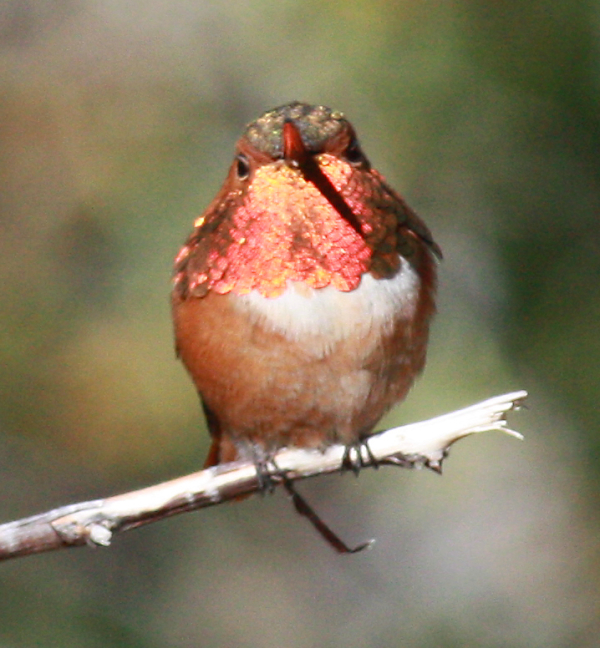
The shape and arrangement of feather melanosomes can influence the way light reflects off them and produces the bright iridescent colors of some hummingbirds, such as this displaying male Allen’s Hummingbird.
|
Many species of hummingbirds can be counted among the most brightly-colored objects in the world. Their most colorful feathers are iridescent, and while some other birds like ducks have some brightly colored feathers, none seem to rival iridescent hummingbird feathers – and scientists weren’t sure why. But the results of a new research study describes that although hummingbird feathers have the same basic makeup as other birds’ feathers, the special shape of their pigment-containing structures enables them to reflect a rainbow of light.
“The big question that keeps me up at night is: Why are some groups of birds more colorful than others?” confided Chad Eliason, the paper’s primary author, who is a post-doctoral researcher at the Field Museum of Natural History in Chicago. “You can look out your window and see drab brown birds, and then you have this glittering gem flutter to your hummingbird feeder. Why are hummingbirds so colorful? Is it the environment, is it sexual selection? Or is it something about the internal mechanisms – the physics and the way colors are produced?”
To answer these questions, Dr. Eliason and his international team of colleagues conducted the largest-ever optical study of hummingbird feathers. They examined the feathers of 35 species of hummingbirds with transmission electron microscopes and compared them with the feathers of other brightly-colored birds, like green-headed male Mallards, to look for differences in their make-up.
All birds’ feathers are made of keratin, the same material as our hair and nails, and they’re structured like tiny trees, with parts resembling a trunk, branches, and leaves. The “leaves” are called feather barbules, which are made up of cells that contain pigment-producing organelles called melanosomes. People have melanosomes too; they produce the dark melanin pigment that colors our hair and skin. But pigment isn’t the only way to create color. The shape and arrangement of melanosomes can influence the way light bounces off them, which can produce bright iridescent colors.
“We call these iridescent colors ‘structural colors’ because they depend on the structural dimensions,” explained co-author Matthew Shawkey from Belgium’s University of Ghent. “A good analogy would be a soap bubble. If you just look at a little bit of soap, it’s going to be colorless. But if you structure it the right way, if you spread it out really thin to form the shell of a bubble, you get those shimmering rainbow colors around the edges. It works the same way with melanosomes: With the right structure, you can turn something colorless into something really colorful.”
Eliason added, “In mammals, the melanin isn’t organized in any fancy way inside of the hairs, but in birds, you get these layers of melanosomes, and when light bounces off the different layers, we see bright colors.”
But even among birds, hummingbird melanosomes are especially unique. Ducks have log-shaped melanosomes without any air inside, but hummingbirds' melanosomes are pancake-shaped and contain lots of tiny air bubbles. The flattened shape and air bubbles of hummingbird melanosomes create a more complex set of surfaces. When light reflects off these complex surfaces, it bounces off in a way that produces iridescence.
The researchers also found that the different traits that make hummingbird feathers special – like melanosome shape and the thickness of the feather lining – are traits that evolved separately, allowing hummingbirds to mix and match a wider variety of traits. All in all, hummingbird feathers are super complex, and that’s what makes them so much more colorful than other birds.
The authors also note that this project opens the door to a greater understanding of why hummingbirds develop the specific colors that they do. “Not all hummingbird colors are shiny and structural – some species have drab plumage, and in many species the females are less colorful than the males,” noted co-author Rafael Maia, a biologist and data scientist at Instacart.
“In this paper we describe a model of how all these variations can be achieved within feathers. Now other wonderful questions appear,” said co-author Juan Parra from Colombia’s Universidad de Antioquia. “For example, if it is possible to display a wide variety of colors, why are many hummingbirds green? Whether this reflects historical events, predation, or female variation in preferences, these are still open and challenging questions.”
Dr. Eliason added: “This study sets the stage for really understanding how color patterns are developed. Now that we have a better idea of how feather structure maps color, we can really parse out which genes are underlying those really crazy colors in birds.”
To review the original article and reference the scientific publication, see ScienceDaily at https://www.sciencedaily.com/releases/2020/01/200110110909.htm